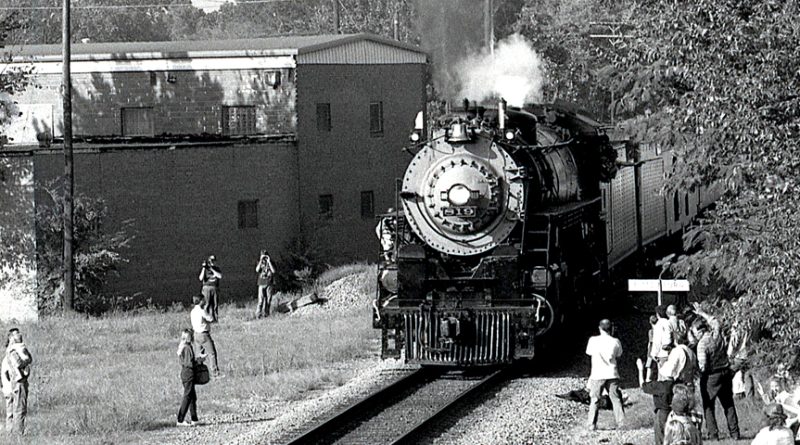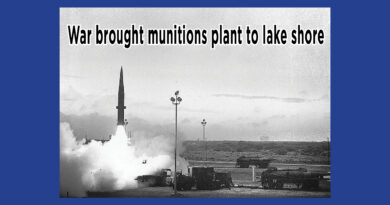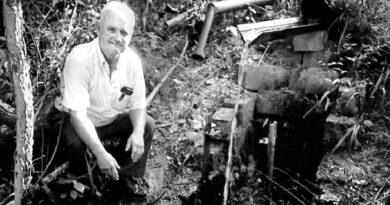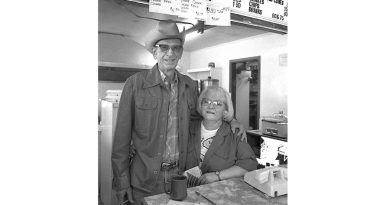Town gears up for arrival of the #819 Cotton Belt Star
From East Texas Journal, November 1993
By Hudson Old, Journal publisher
Pittsburg, Texas – #819 Cotton Belt Star – It was late afternoon on a Friday, and we’d all gathered at the depot to wait on the #819, also called the Cotton Belt Star. The Mayor Abernathy was down there with a bull horn, telling us to clear the tracks because a freight train had to pass before the #819 got in, as if we didn’t have enough sense to get out of the way of a train, which was possible because the vision of the #819 coming by again had everybody preoccupied.
From my perch on top of the depot, where Chuck Harris had deposited me for best camera view, I watched a couple of kids working on something down on the track — maybe putting a coin there, I hoped.
Chuck Harris was down there standing where the track crossed the street, checking the red line he’d spray painted on the pavement. It showed the exact overhang of the #819 Cotton Belt Star’s engine outside the actual tracks, a mark he needed to know so he wouldn’t get his kneecaps knocked off as he passed up a note to the fireman when the train shot past.
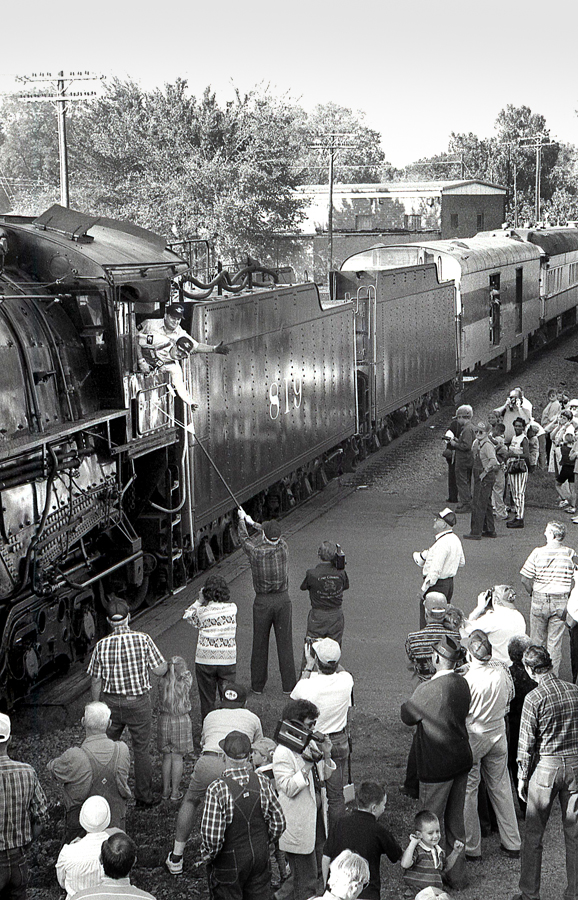
No matter that the engine was going to stop 200 yards down the track, Chuck had spent the morning getting ready to use the hoop out of the museum to pass up the note. The note read:
“Here’s my $50 to join your fine organization, the National Rail Historical Society. We’ve got some Pittsburg hot links for you. Signed, Chuck Harris, Director of Rail Depot Exhibit; Pittsburg/Camp County Award Winning Museum Association’s Northeast Texas Rural Heritage Center.”
A hoop is a long forked stick with a note on a string between the forks, the sticks depot guys in the old days used to pass up messages to passing trains.
It wasn’t just some hoop. It was the hoop Chuck Harris “confiscated” one day out of the crumbling old railroad depot, and didn’t bring back until Mayor Abernathy called him and said the museum needed it. Chuck brought back the hoop, plus set up the station telegraph office and the train exhibit — re-create the 1940s is what he did.
He’d spent most of the afternoon getting ready to pass the message. He’d diagrammed the event, drawing off everything to scale, with dimensions of the tracks, the train, the ground to air height of the window the fireman would be leaning from as he shot past — after giving it some thought, he went back out and painted a second red line on the pavement, marking the spot he’d stand.
“That’s the hat you’re planning to wear, Chuck?” museum outfit Pres John Holman asked. Chuck’s hand went to the brim of his Union Pacific golf cap. “What’s wrong with it?” he asked.
“Well, is that the kind of cap a railroad agent would have worn? This ain’t some Disney Land fantasy, ya know. Either let’s do this deal right or do something else.” Chuck stopped to think about it.
“Well, what kinda hat did Mr. O’Quinn wear back then?,” Bob Turner suggested.
Mr. Turner, Mr. Harris and Mr. Holman were all retired guys — at least they no longer had paying jobs. They worked for their home town’s museum. So did about 70 other people.
Ask how to get a museum built, stocked, up and running in a year, and Mr. Holman couldn’t do anything but shrug.
“You can’t,” he finally said, “unless you have a town like Pittsburg. Then you can.”
Early on, town founder William Harrison Pitts saw the opportunity the railroad presented for the antebellum cotton and timber industries at the heart of an East Texas economy. The town gave right of way to the Tyler Tapp. In 1875, a year after Camp County was carved out of Upshur County and Pittsburg named county seat, Mr. Pitts donated a lot for a depot. In 1901, Cotton Belt built the present depot.

Decades passed and as the trucking industry grew, rail shipping’s importance diminished. Affordable automobiles undermined passenger train travel.
In the mid 50s, passenger service to Pittsburg ended. In 1968, Cotton Belt pad-locked the depot.
An era ended for Mr. Harris, and C.C. Gaston, guys who worked at the Pittsburg depot. Mr. Harris began hanging around the depot before he wore shoes in the summer and wound up running the place until he saw the writing on the walls and went to work as a designer for Texas Eastman down at Longview.
Economics pulled the plug on even freight delivery here by 1970, wrote Vernon Holcomb, a retired Air Force colonel, returned to his home town to feed a few cows, drive a slow tractor and work for the museum. He was the resident research guy, poking through cobwebbed old papers, researching local legends, getting it all in writing. The state hung several historical plaques based on his stuff.
About the depot, the railroad wouldn’t put money into a facility they didn’t use and the town wasn’t going to spend money on something they didn’t own, so for the 20 years before 1990, the old depot got caught on high center while vandals, rain and pigeons took their toll.
Museum President John Holman grew up here too, son of a traveling salesman, became a traveling salesman himself. Sold furniture, and for a while, had a furniture store here. Then he bought the Adele Hunt Furniture & Studio in Dallas’ University park, an “upscale” store.

“What he means by ‘upscale’ is you can go in there and spend fifteen grand on a kitchen table if you want to,” Mr. Turner said.
By the 70s, he’d moved his family to Dallas, by ’85 when he sorta unofficially retired with his airplane and his motor home, bought a little farm west of town and made himself a landing strip.
Having kept his company American Express “strictly for business purposes,” whenever he got back to Pittsburg he opened The Pittsburg Antique Center so he’d have a business.
“Coming back home from Dallas it was easy to see what could happen in Pittsburg with all the interest the people were taking in their town,” Mr. Holman said. “Tourism’s such a great industry to develop . . .”
Pittsburg needed a museum. The mayor and them had offered the railroad $9,000 for the old depot. The railroad wanted $50,000.
Mr. Holman made it a point to meet the railroad’s Dallas-based real estate man, Richard Coleman.
Plots hatched.
“In one conversation, I finally suggested that the depot was in ruins and that when the city condemned it as the fire and health hazard it had become, the railroad would be spending more than $50,000 to demolish it. He called back the next day and took the city’s $9,000.”
August 1, 1990, the museum association leased the ruined depot from the city for $1 a year. Somewhere in there, the mayor called Mr. Harris to bring back the stuff from the depot. Volunteers descended like locusts with hammers, paint and wrecking bars. The museum begged, brow beat and bribed the community to donate money and exhibit items.
Mr. Turner, a retired aeronautical engineer with a passion for local archeology, began putting together his exhibit of native Indian artifacts spanning centuries here.
It was one of five exhibit areas in the museum then, all centered around the farming and timber businesses — Pittsburg/Camp County’s Rural Heritage Center.
” I have to remind these guys daily that this isn’t just a railroad museum,” Mr. Holman said. Propelled by the sweat of masses the museum opened August 31, 1991.
“We were dead beat and as proud as we’d ever been of anything we’d ever done,” Mr. Holman said.
Railroad museum or not, when the museum committee met the morning before the #819 Cotton Belt Star rolled through, the train was heavy on the agenda.
Built in 1943, the #819 Cotton Belt Star was the last steam engine to roll out of the shop in Pine Bluff, Arkansas, said Peter Smykla, director of the Cotton Belt Chapter of the National Rail Historical Society in Pine Bluff.
By ’43, state-of-the-art diesel locomotives had replaced steam engines, but the war department allocated who got them, so the Cotton Belt circled the war department’s regulations and built five steam engines. The #819 Cotton Belt Star went into service in 1943, was retired in ’55, donated to the city of Pine Bluff and placed in the park. In 1983, it took the historical at Pine Bluff $147,000 to restore the #819, bringing her back to life as “The Cotton Belt Star.” It burns #5 fuel oil. That’s about asphalt, said Mr. Smykla.
The day it was due through Pittsburg, the museum people were busy as elves making way for the king. The committee met bright and early. It was reported that the committee had acquired 60 dozen Pittsburg Hot Links from the Warrick family, 30 for the #819’s crew and 30 for her passengers. The Mayor was showing off the railroad’s official historical publication because he’d gotten a story put in it. The train planned a 40-minute stop at the Pittsburg depot, the only depot between Pine Bluff and Tyler to be so honored.
A list of refreshments to be served passengers touring the museum was finalized. It was decided that in the event the train ran late and didn’t stop to tour the depot, the hot links were to be preserved by freezing; warmed and served at the next committee meeting.
Committee member Nina Johnson asked if anybody would like to buy a raffle ticket to help out the hospital volunteers.
Mr. Holcomb passed around a study that showed that people who volunteer outlive un-volunteers by 10 years.
Mrs. Gloria Turner wanted to discuss a new way of recruiting volunteers to man the museum during operating hours since the old method was growing a little thin. Since she was the person always willing to go run the place when nobody shows up, she’d been among the first to notice the problem.
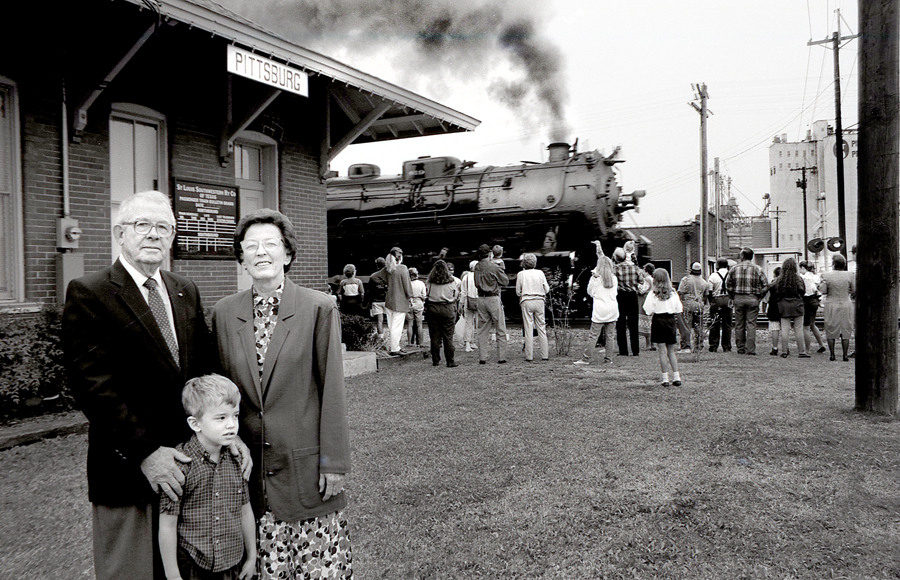
“She was the volunteer who had always come along and picks up the pieces,” Mr. Holman said. Like the time when it was decided to publish and sell a cookbook, then really big developments sidetracked the project.
“One of the real benefits of having Gloria is that if you get her, you’ve got Bob since he’s always with her,” Mr. Holman said. “Works out good.”
The big project that got in the way of the cookbook was the farmstead museum, which again involved complete restoration of a once-abandoned shell, an old dog trot home that was envisioned as, well, an old farmstead. With chickens and a smokehouse and where volunteers will come down and run a grist mill for school kids.
The old Hoffman House was moved to the museum’s second project site after Mr. and Mrs. James Whatley — that’d be Jim and Elizabeth — donated money to buy the lot, move the house and roof it.
At the committee meeting, Mr. Holman was put out that the volunteer carpenter recruited by Mr. Billy Law, lumber business, hadn’t showed up to do his volunteer work on the Farmstead project and Mr. Holman wanted the volunteer fired and another volunteer hired. After much discussion, it was decided that the volunteer carpenter could be offered a 1-year individual museum association membership, a $25 value, for completing his assigned task.
Mayor Abernathy, who kept minutes on everything in town he had belonged to, which was everything, rattled papers.
“What?” Mr. Holman said.
“What about our sign,” the Mayor said. “It says right here in the minutes from the previous meeting that somebody’s supposed to do something about the sign in front of the Garrett building, plain as day. Who’s done anything about it?”
“Did you?” Mr. Holman asked.
“No, I didn’t, did you?”
“Well, you’re just supposed to read the minutes, not bawl us out,” Mr. Holman said.
“Well, you’re the president and when we agree to get something done it’s your responsibility to get something done,” the Mayor said, then gave that jut of his jaw that ended most given topics in his half century as mayor.
From my perch on top of the depot, the camera angle I’d been assigned by Mr. Harris, I could see black smoke billowing above the trees in the distance; heard the dinosaur puff of the steam engine.
Just below me, clinging with elbows and knees to the station semaphore (that’s some deal atop a tall ladder), Vernon Holcomb balanced a camcorder at the camera angle he’d been assigned.
The mayor was on his bull horn again, telling us to clear the tracks again, that the #819 was just around the bend, but we already knew it.
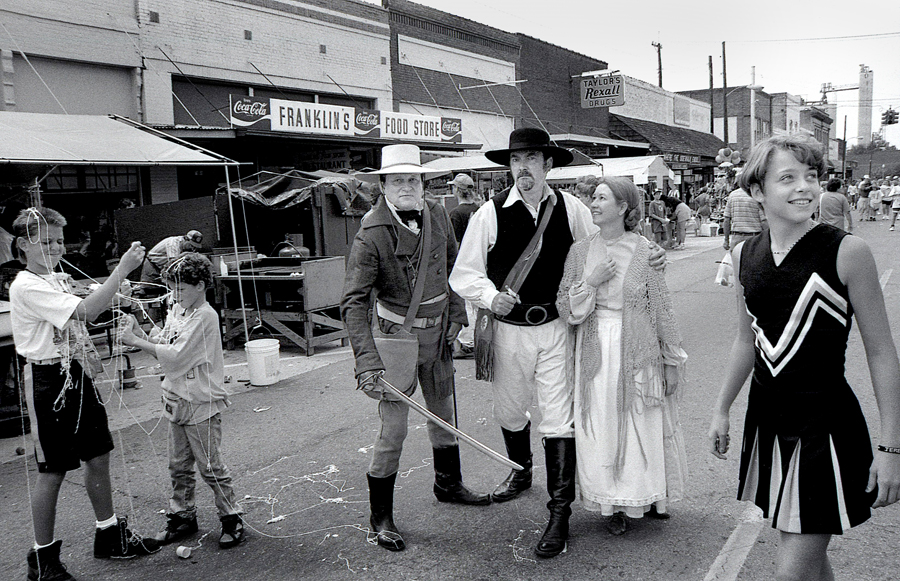
Chuck Harris came around the comer of the depot, walked out to the track with his hoop, stationed himself at red line two. The train was coming now, steaming down on Chuck’s note and the rest — he still wore his baseball cap.
The hat discussion ended with Chuck’s response to Mr. Turner’s question about what kind of hat Mr. Pat O’Quinn had worn back in the old days.
“He wore HIS hat, Chuck said. “This cap’s MY hat.”
The fireman on the #819 Cotton Belt Star, a fireman who’d never caught a message out of a hoop before, snatched Chuck’s note and his $50 from the hoop as the #819 steamed by; people leaned out the passenger cars and waved at us and we all waved back, then the train stopped, the museum people cut their prices and charged only a dollar a head to get in, everybody ate some hot links and looked at stuff, then with a huff and a puff the train was gone again, the locals filtered away, and the museum volunteers secured their dream, and swept the floors.
Out in the parking lot, Mr. Holman borrowed a hammer from Mr. Turner.
” I gotta go fix that sign,” he said.


